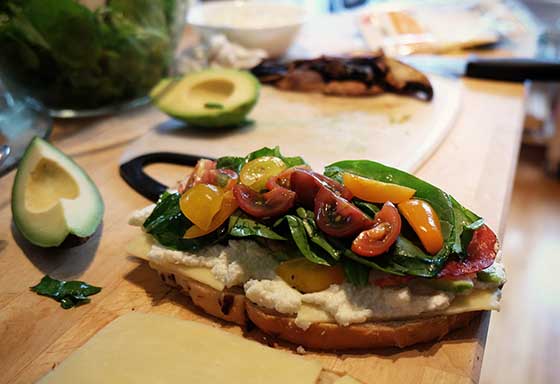If you’re looking to lose weight or feel better, eating more vegetables is key.
Adding vegetables to your diet helps you feel fuller for longer, and will help give you the energy you need to stay alert throughout your day. Also, loading up on veggies can help you:
- Perform better in your job, workouts and daily life
- Have glowing skin, healthy eyes and improved digestion
- Maintain a healthy weight and body composition
- Decrease your risk of Heart Disease
- Decrease your risk of Type II Diabetes
- Decrease your total and LDL (bad) cholesterol
- Lower blood pressure
- Decrease your risk of developing other chronic diseases, including cancer (breast, colon, prostate and pancreatic cancers)
- Decrease your risk of stroke
- Increase your immune function
Need we say more?
Simple ways to eat more vegetables
It’s easy to say, “eat more vegetables,” but it can be tough to sneak in that recommended amount, about 3 cups, into your diet – especially if you don’t find them appealing.
So how can you begin to eat more of these fiber-rich foods in a practical way that you enjoy?
Here are some ideas to get you started!
1. Go meatless
Just temporarily! Try being meat-free for just two meals a day, or go completely vegetarian one day per week. You can swap out meats with plant-based protein like nuts, beans, tofu, and edamame – all of which will expand your vegetable horizons while still keeping you full and satisfied.
2. Cook them quickly
Keeping frozen vegetables, such as broccoli or a stir fry blend, on-hand in your freezer is a great way to ensure time is not a barrier to your vegetable consumption. Simply steam them in the microwave, and you will have a quick and colorful addition to any meal!
3. Prep ahead
Use the weekend to chop up some fresh veggies for use later in the week. You can slice some bell pepper or carrot strips for a quick snack, or fix up some broccoli and snap peas to throw in stir fry dinner.
4. Vegetables at breakfast
Breakfast is a meal that is often overlooked for increased veggie intake. Try sneaking in some sliced mushrooms, leeks, peppers, tomatoes, or spinach in with your morning eggs.
5. Start off on the right foot
Eat your veggie-packed dishes at the beginning of your meal, instead of putting them off to the end. This will help you eat more vegetables and less of the higher-calorie foods on your plate.
6. Soup it up
Vegetable or tomato soups can make a great snack. To make it a meal you can add some beans or lean meats. Just watch out for pre-packaged or canned soups, which often pack in a lot of sodium.

Vegetable or tomato soups can make a great snack.
7. Celebrate the season
Try cooking seasonal vegetables, even the ones you have never cooked in the past. Local markets are a great place to shop for in-season treats. This tends to be cheaper and pack more flavor than out-of-season vegetables. You can even try growing your own and enjoy the fruits of your labor!
8. Re-think your restaurant choice
Eating at restaurants tends to lead to eating very high-calorie meals. When you go out, choose meals with high vegetable content, such as stir fry or salads. You can also ask the waiter to replace starchy sides with yummy grilled or steamed vegetables.
9. Snack smart
Power through your day with an energizing new snack. Pair raw vegetables with hummus, yogurt or black bean dip, or salsa.
10. Add flavor
Break the boring vegetable routine! Try grilling vegetables like zucchini, peppers and eggplant. Or, if you would rather stay inside, roast vegetables like broccoli and brussels sprouts to develop their natural, sweet flavors.
You’ll find that it is much easier to reach your goals if you enjoy the process. To increase your vegetable intake, pick a strategy or two that you feel comfortable doing and aim to add just one more serving of vegetables each day. Happy eating!
[fusion_separator style_type=”single solid” hide_on_mobile=”small-visibility,medium-visibility,large-visibility” class=”” id=”” sep_color=”#1f86c8″ top_margin=”” bottom_margin=”” border_size=”” icon=”” icon_circle=”” icon_circle_color=”” width=”” alignment=”center”][/fusion_separator]
Get your Calorie Counting Debunked guide
Counting calories isn’t the only way to achieve your fitness goals. Fortunately, you can skip out on the stress of calorie counting and still lose fat. Learn the practical approach to eating well and the trade-offs of getting lean.
Get the “Calorie Counting Debunked” guide here.
Make Eating Well Second Nature This April
This April we will be launching our online 8-week nutrition program. When you sign up, you’ll join others on the same quest of making healthy eating second nature. During the course, you will learn to how to integrate nutritious habits into your lifestyle. Yes, you will have to change your eating habits, but you will get all the support and accountability you need to be successful.
If you’re tired of dealing with fitness fads and are looking for sustainable, practical guidance, then you can learn about the program here.
By: Morgan Davis, RD, LDN’
(This article was updated on February 28, 2017)

